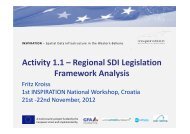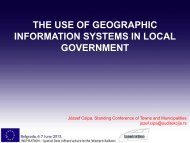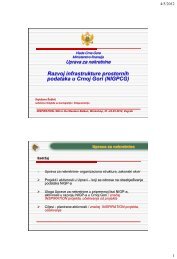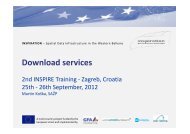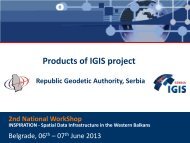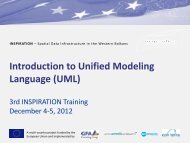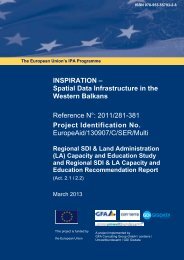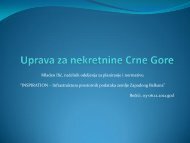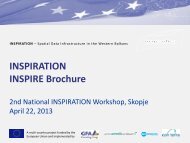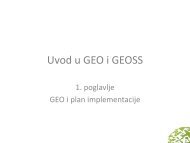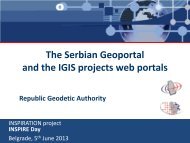MOVE - Moderation and Visualization for Group ... - INSPIRATION
MOVE - Moderation and Visualization for Group ... - INSPIRATION
MOVE - Moderation and Visualization for Group ... - INSPIRATION
Create successful ePaper yourself
Turn your PDF publications into a flip-book with our unique Google optimized e-Paper software.
University of Hohenheim, Uwe Krappitz <strong>and</strong><br />
Manfred Oepen – were integrated. A special<br />
moderation <strong>and</strong> training approach was developed,<br />
meeting the needs of intercultural,<br />
professional experience exchange <strong>and</strong> aimed at<br />
generating solutions to complex socio-economic<br />
problems in a wide range of fields <strong>and</strong> situations<br />
of international development cooperation. Maybe<br />
the overruling principle of what later became<br />
<strong>MOVE</strong> – <strong>Moderation</strong> <strong>and</strong> <strong>Visualization</strong> <strong>for</strong> <strong>Group</strong><br />
Events is the belief in the creative <strong>and</strong> intellectual<br />
potential of every person involved in a learning<br />
process.<br />
The process is put into practice by continuous<br />
<strong>and</strong> mobile visualization, as will be explained in<br />
more detail in Part 4. The visualization facilitates<br />
active participation, because all the participants<br />
cooperate in visualizing the contributions. It<br />
rein<strong>for</strong>ces the learning effect <strong>and</strong> raises the<br />
intensity <strong>and</strong> quality of communication by<br />
making use of other senses than hearing. The<br />
visualization makes the working process transparent<br />
<strong>and</strong> easier to comprehend as it helps to<br />
bridge language <strong>and</strong> psychological gaps. This<br />
results in ownership on the participants’ side,<br />
creating motivation <strong>and</strong> significantly increasing<br />
the social integration of the group. However, the<br />
training approach can only be applied successfully<br />
if all partners – organizers, participants,<br />
moderators <strong>and</strong> trainers – fully cooperate with<br />
each other in creating a favorable social atmosphere<br />
in which all persons mutually respect<br />
each other. Working principles such as “Each<br />
idea counts” or “Everybody helps each other”<br />
applied throughout all group events reflect this<br />
atmosphere.<br />
The same Quickborn Team in Germany that<br />
established Metaplan, by the way, also inspired<br />
the widely-known ZOPP method (Goal-oriented<br />
Project Planning) developed by the Gesellschaft<br />
für Technische Zusammenarbeit – GTZ. But that<br />
is not only another story, it also confuses many<br />
observers with what is here called <strong>MOVE</strong><br />
because the ‘hardware’ – the cards <strong>and</strong> boards<br />
etc. – is the same. However, the ‘software’, that is<br />
the philosophy <strong>and</strong> ethics, are quite different.<br />
ZOPP allows groups to <strong>for</strong>mulate problems <strong>and</strong><br />
objectives through a logical framework approach<br />
working within well-defined development<br />
18<br />
projects backed by specific resources. But the<br />
rigid structure makes ZOPP less adaptable to<br />
complex situations such as planning among a<br />
broad alliance of partners <strong>and</strong> may hinder an<br />
integral underst<strong>and</strong>ing of the diversity of local<br />
situations. As GTZ used ZOPP as a requirement<br />
in development assistance around the world <strong>for</strong><br />
more than 20 years, visualization techniques<br />
have been very often identified with this approach.<br />
Ironically – <strong>and</strong> very differently from the<br />
use Metaplan was put to in Germany – the<br />
underlying visualization ‘hardware’, the cards<br />
<strong>and</strong> boards, <strong>and</strong> the ‘software’, or logical framework,<br />
originated from military planning (see<br />
VIPP 1993). Then U.S. Secretary of Defense,<br />
Robert McNamara, used this hard- <strong>and</strong> software<br />
to coordinate war logistics in trying to win the<br />
Vietnam War. He tried in vain as we all know. It<br />
is part of the historical irony that DSE’s Center<br />
<strong>for</strong> Public Administration (ZÖV) employed<br />
<strong>MOVE</strong> – <strong>and</strong>, hence, part of the same ‘hardware’<br />
– with great <strong>and</strong> lasting success in Viet Nam.<br />
Two of the Vietnamese <strong>MOVE</strong> specialists trained<br />
in the process helped elaborate this manual.<br />
So, <strong>MOVE</strong> is a set of methods, instruments <strong>and</strong><br />
competences that share a philosophical plat<strong>for</strong>m<br />
derived from creative processes of dialogue. To<br />
the Greek, dia logos was “the uninhibited flow of<br />
meaning” within a group which provided<br />
insights that the individual would not gain by<br />
himself. Today, we would call this “team learning”<br />
(see Senge 1990:19). Un<strong>for</strong>tunately (<strong>and</strong>



